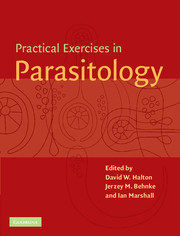Book contents
- Frontmatter
- Contents
- List of contributors
- Preface
- General advice
- 1 Observational Exercises on Parasites
- 2 Ecology
- 3 Physiology and Biochemistry
- 4 Pathology and Immunology
- 5 Chemotherapy
- 5.1 Sensitivity of a coccidial parasite, Eimeria, to an ionophore, monensin
- 5.2 Egg hatch assay for determination of resistance of nematodes to benzimidazole anthelmintics
- 5.3 Larval migration inhibition assay for determination of susceptibility of nematodes to levamisole
- 5.4 Effect of anthelmintics on nematodes
- 6 Molecular Parasitology
- 7 Behaviour
- Appendix 1 Reagent index
- Appendix 2 UK suppliers
- Appendix 3 US suppliers
- Index
5.1 - Sensitivity of a coccidial parasite, Eimeria, to an ionophore, monensin
Published online by Cambridge University Press: 05 June 2012
- Frontmatter
- Contents
- List of contributors
- Preface
- General advice
- 1 Observational Exercises on Parasites
- 2 Ecology
- 3 Physiology and Biochemistry
- 4 Pathology and Immunology
- 5 Chemotherapy
- 5.1 Sensitivity of a coccidial parasite, Eimeria, to an ionophore, monensin
- 5.2 Egg hatch assay for determination of resistance of nematodes to benzimidazole anthelmintics
- 5.3 Larval migration inhibition assay for determination of susceptibility of nematodes to levamisole
- 5.4 Effect of anthelmintics on nematodes
- 6 Molecular Parasitology
- 7 Behaviour
- Appendix 1 Reagent index
- Appendix 2 UK suppliers
- Appendix 3 US suppliers
- Index
Summary
Aims and objectives
This exercise is designed to demonstrate the sensitivity of sporozoites, the invasive stages of coccidial parasites, to ionophorous drugs.
Specifically, the practical will examine:
How sporozoites may be recovered from transmission stages, the oocysts of the coccidial parasites, by a combination of physical damage and enzymatic digestion (via an intermediate sporocyst stage).
The lethality of the ionophore, monensin, to extracellular sporozoites by incubating the mixture of sporozoites, with remaining intact sporocysts and oocysts, in the presence of different concentrations of the drug.
Introduction
Coccidial protozoa are found wherever poultry are reared and an absolute need to prevent or control infections in commercial meat and egg-laying flocks has led to the use of many anticoccidial drugs. The most useful drugs continue to be the ionophorous antibiotics, even though widespread resistance to these drugs has been reported for many years. The drugs act by taking up residence within the cell membrane (pellicle) of the transiently extracellular stages, the sporozoites and merozoites, where they interfere with ion transport across the membrane. The test to be demonstrated in this practical is based on the viability/distortion and/or lysis of sporozoites as the drug interacts with the cell membranes of the parasite and interferes with the functioning of the ATP-dependent pumps that regulate the concentration of intracellular cations. It is thought that the drug acts as a pore in the membrane so that ions, commonly sodium, magnesium or calcium, may move from the outside milieu via the ionophore into the cytoplasm of the parasite.
- Type
- Chapter
- Information
- Practical Exercises in Parasitology , pp. 305 - 312Publisher: Cambridge University PressPrint publication year: 2001



